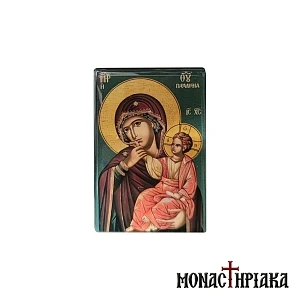Where is the Holy Monastery of Esfigmenou and when was it founded?
The Holy Monastery of Esfigmenou is located in a small bay, on the north-eastern side of the Athos Peninsula, near the Monastery of Hilandari.
According to tradition, the monastery was founded in the 5th century by Emperor Theodosius II and his sister, Empress Pulcheria. However, historical evidence records the existence of the Monastery of Esfigmenou in the 10th century. The Monastery is mentioned for the first time in 998 AD. with the name "Esfagmenou" in official paper of the Holy Great Monastery of Vatopedi.
A few years later, in 1037, the Monastery was renamed "Esfigmenou" and went through a long period of prosperity. In fact, in the year 1045 in the "Typiko of Monomachus" the Holy Monastery of Esfigmenou is in fifth place in the hierarchy of the monasteries of Mount Athos. Today, the Monastery is in the 18th hierarchical position among the monasteries of Mount Athos.

The period of decline of the Holy Monastery of Esfigmenou and the important personalities
In the middle of the 13th century, the Monastery of Esfigmenou faced significant difficulties and gradually fell into obscurity. Then, it recovers and for the next two centuries, until the conquest by the Turks, the Monastery of Esfigmenou goes through another great period of prosperity. Many emperors of Byzantium, as well as rulers of other Orthodox countries, contributed significantly to the prosperity of the Monastery.
Important personalities who settled in the monastery were, among others, the later Patriarch of Constantinople Athanasios and Saint Gregory the Palamas. In fact, Saint Gregory Palamas was the abbot of the Monastery of Esfigmenou for some years (1335-1338 AD).
Pirate raids hit the Monastery of Esfigmenou
The seaside location of the Monastery offered protection from the weather, but at the same time made the Monastery an easy target for raids by Agarean and Turkish pirates. Numerous lootings, raids and arsons affected the Monastery of Esfigmenou and led it to a long period of great depression.
The pirate attacks, combined with the devastating fire of 1491, led to the decline of the Monastery, as a result of which it was threatened with complete desolation after 1533.
Until the 17th century, the Holy Monastery of Esfigmenou went through particularly difficult times and reached a difficult financial situation. However, from the 18th century onwards, the Monastery is on a new course of reorganization and reconstruction.

The Reconstruction of the Holy Monastery of Esfigmenou
In the reconstruction process of the Esfigmenou Monastery, the effort of Metropolitan Melenikos Grigorios is leading the way, who prioritized the repayment of the debts of the Monastery.
The activity of Theodoritos Lavriotis during the 19th century (1804–1806) was also noteworthy, putting a lot of effort into the proper communal functioning of the Monastery. During the time that Theodoritos was abbot, the foundations of the new Catholic Church were laid, while at the same time, the reconstruction of the Bank of the Monastery and other important buildings began.
The Monastery of Esfigmenou during the Revolution of 1821
In 1821 the Holy Monastery of Esfigmenou was occupied by a Turkish army for more than 10 years (1821-1832). In 1832 Agathangelos Kallipolitis undertook the reconstitution of the Monastery, powerfully managing the Monastery for 40 whole years (1832-1871). Abbot Agathangelos's contribution was significant, as he undertook to rebuild most of the buildings of the Monastery: the bell tower, the chapels, the exonarthex of the Church and the meridian pillar.
However, in the following years, until the beginning of the 20th century, various movements led the Esfigmenou Monastery to a large debt of 4,000 Turkish Liras. The Monastery managed to cope with the difficulties and repay the debt, without resorting to inappropriate loans from foreigners.

Panagia Arsaniotissa: How the icon of Panagia was miraculously saved
The holy and wonderful icon of Panagia Arsaniotissa took its name from the arsana (=port) of Esfigmenou Monastery, as it was placed there for years. In December 1892 there was a large landslide due to heavy rainfall. That night, large rocks from the mountain of Samaria fell and destroyed a large part of the port.
Among the debris, the only thing miraculously saved was the part of the wall that protected the shrine with the icon of the Virgin Mary. When the monks took the icon, then this small part of the wall also collapsed. In front of the shrine, a lay fisherman, named Nikolaos Karamaniolas, was sleeping and miraculously he was unharmed by the intervention of the Virgin Mary. Since then, the icon of Panagia Arsaniotissa has been in the main Church, until today.

The Church of the Monastery of Esfigmenou, the Library and the Holy Relics
The Church of the Holy Monastery of Esfigmenou is located on the west side of the courtyard and is dedicated to the Ascension of the Lord. In 1808 Abbot Theodoritos laid the foundations and three years later, in 1811, Patriarch Gregory V inaugurated it. The Church is enriched with wonderful frescoes by Galatsan painters, Benjamin, Zacharias and Makarios. The most holy icon of the Monastery is of the icon of Virgin Mary Eleousa.
Among the most important and sacred relics of the Monastery of Esfigmenou is the Cross of Pulcheria, as well as a large piece from the scene of Napoleon the Great. This piece is used as a covering on the gate of the Church during the festival. In addition, holy relics of Saints are kept in the sacristy of the Monastery.
The Library of the Monastery of Esfigmenou is located above the Narthex of the Church and has approximately 6,000 printed books. In addition, there are 372 manuscripts, of which 75 of them are parchments and scrolls. Another special relic is the Menologio of the 11th century, which contains 80 miniatures and 8 representations from the Nativity of Jesus Christ. Finally, the Chrysovulo of Maros of 1428 depicts the family of the Serbian Ruler Bragovic.
Contact with Esfigmenou Monastery:
Phone: +30 2377 0 23653
Email: info@espfigmenou.gr















